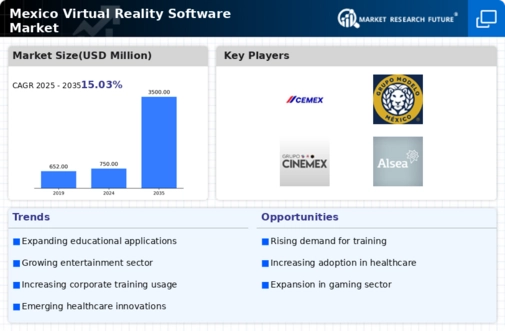The Mexico Virtual Reality Software Market is a rapidly evolving sector that has captured the attention of numerous players seeking to leverage the increasing demand for immersive experiences across various industries, including gaming, education, and real estate. The competitive landscape is characterized by a blend of established technology firms and innovative startups specializing in virtual reality (VR) solutions. These companies are continuously refining their offerings and exploring new applications for VR technology to enhance user engagement and overall experience.
As the market expands, firms are also focusing on developing partnerships and collaborations to drive growth and maintain competitiveness amid a growing pool of competitors.In the context of the Mexico Virtual Reality Software Market, Valve stands out due to its strong foothold and innovative product offerings.
The company is recognized for its advancements in VR gaming, with a technology ecosystem that includes a comprehensive hardware and software integration, elevating the standard for virtual gaming experiences. Valve’s Steam platform is a dominant force in the distribution of VR titles in Mexico, providing a marketplace that enhances accessibility for consumers and developers alike.
Their commitment to user experience and ongoing development of content tailored specifically for the Mexican audience further solidifies their competitive edge and strengthens their market presence in the region. Valve's focus on supporting developers through various initiatives adds to their strengths, ensuring a rich and diverse portfolio of VR experiences accessible to Mexican consumers.NVIDIA plays a crucial role in the Mexico Virtual Reality Software Market with its cutting-edge graphic processing units (GPUs) designed to optimize virtual reality experiences.
The company has positioned itself as a key enabler of high-performance VR applications, with products that cater to both gaming and professional sectors. NVIDIA’s collaboration with local developers and content creators fosters an ecosystem that encourages innovation and supports the growth of VR content in Mexico. Their GPUs are pivotal in enhancing the graphical fidelity and performance of VR software, making it a strong contender in the competitive landscape.
Moreover, NVIDIA has engaged in strategic partnerships and acquisitions that bolster its market presence, allowing the company to offer comprehensive solutions and maintain its leadership position in the VR domain within Mexico. This ability to provide state-of-the-art visual computing technologies, coupled with localized support for developers, underscores NVIDIA's strengths in the burgeoning Mexican virtual reality market.















Leave a Comment